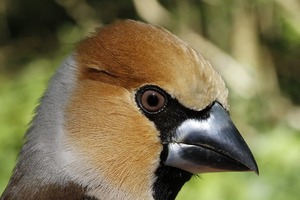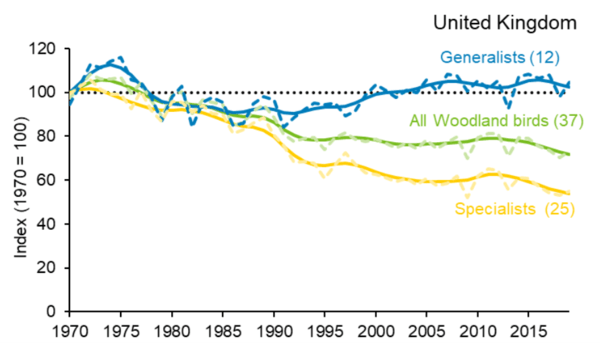 LINKED PAPER
LINKED PAPER
Multi-marker DNA metabarcoding reveals spatial and sexual variation in the diet of a scarce woodland bird. Stenhouse, E. H., Bellamy, P., Kirby, W., Vaughan, I. P., Drake, L. E., Marchbank, A., Workman, T., Symondson, W. O. C. & Orozco-terWengel, P. 2023 Ecology and Evolution. doi: 10.1002/ece3.10089 VIEW
Many British woodland bird species have declined over the last 50 years. Reasons behind these declines are far from straightforward. Declines have been linked to a number of factors, from landscape-level simplification, agricultural expansion, and urban development, to changes in woodland management (Gregory et al. 2007). Furthermore, many declining woodland species do not have adequate ecological information associated with them, resulting in difficulties identifying species specific drivers of population decline.

Figure 1 The changes in abundance of woodland bird species from 1970-2018. Figures in brackets show the number of species. The unsmoothed trends are indicated by dashed lines and smooth trends indicated by solid lines (DEFRA 2018).
A vital part of understanding interactions within ecological communities is to accurately clarify a species’ diet profile, as this plays a pivotal role in defining species’ ecological niche and determining individual fitness (Romano et al. 2020). Animals are often characterised by their diet, and foraging for food can impact other aspects of an animal’s behaviour and survival. Having a specialised dietary niche breadth (e.g., only consuming a small range of dietary items) can increase the vulnerability of dietary specialists when responding to environmentally driven changes in resource availability when compared to generalists. Having detailed dietary information is important for exploring optimal foraging, where the main aim is to maximise quality or quantity of resources, while avoiding predation.
Focusing on birds more specifically, having a high level of knowledge of avian diet, especially from populations in many different places, can help our understanding about the many complex ways birds interact within their environment. But why is this important? Birds can experience different pressures depending on where they live, which can affect their energetic balance and subsequent survival. Therefore, investigating how diet differs spatially is a crucial steppingstone in understanding how populations are locally adapted to the species on which they feed. Despite the clear importance of having this dietary knowledge, currently little to no diet information exists for many woodland birds.
The Hawfinch (Coccothraustes coccothraustes) is the largest member of the Fringillidae family in the UK and is present across Europe, where it breeds (Mountford 1957). However, this accounts for less than half of its global breeding range, which is from Europe to China. The Hawfinch is one of many bird species closely associated with woodland habitats which has shown major declines in the UK. Information regarding Hawfinch ecology is very limited, with minimal research undertaken.

Figure 2 Hawfinch in the hand. All birds were captured, handled and ringed by licensed ringers endorsed by the British Trust for Ornithology (BTO). Photo credit: Andy Stanbury: Hawfinch Ringing Group.
Our recently accepted manuscript in Ecology and Evolution aimed to shed some light on UK Hawfinch diet. We wanted to give an unparalleled insight into Hawfinch diet and whether it differed across the UK, and to explore whether males and females were feeding on similar, or different dietary items.
We used genetic techniques to analyse plant and invertebrate taxa within Hawfinch diet, to try and paint the most complete picture we could. To unravel dietary mysteries, genetics can provide at least some of the answers. Faecal metabarcoding (genetically identifying taxa contained within faecal samples) is a non-invasive, non-destructive method allowing the identification of taxa to high resolution. This method has unlocked the door of allowing researchers to ask previously unanswerable questions about the ecology of rare, cryptic, or even common species (Taberlet et al. 2018).
So, what did the DNA metabarcoding results tell us? We sampled from a total of 11 sites used by local bird ringers across the UK to catch Hawfinches and collect Hawfinch poo! To collect faecal samples without risk of contamination, we placed Hawfinches within a clean, unused paper bag, placed inside a normal cloth bird bag. We left Hawfinches in the bags for 10 minutes, or until the bird defecated. To avoid excessive stress, if birds had not defecated after this time we processed and released them.
Once we had tested all the faecal samples for plant and invertebrate DNA, I was left with 262 samples, collected across three field seasons. Once we had cleaned the data (removing unwanted taxa), 49 plant and 90 invertebrate taxa remained. The most frequently detected plant dietary item was European Beech (Fagus sylvatica), while the Winter Moth (Operophtera brumata) was the most frequently identified invertebrate taxa.
Hawfinch diet was found to differ significantly across the UK. Although we found over 100 taxa consumed, we found that previously recorded common food resources such as beech, cherry, and Lepidoptera are frequently consumed. This highlights the power of metabarcoding techniques within bird ecology and in particular its relevance to passerines that feed on diverse and difficult to identify taxonomic groups, such as insects.

Figure 3 Spider plot for plant and invertebrate taxa consumed by Hawfinch in different geographic regions. Smaller nodes represent individual Hawfinch with connecting lines joining the individual to the mean centroid (larger nodes) of its region.
We discovered that Hawfinch were consuming a wide range of dietary taxa. Interestingly, many dietary taxa were consumed in very low frequencies by Hawfinch, suggesting they may be opportunistically consuming many species, but show consistent feeding on a small number of key food items. Our findings on the more commonly eaten dietary items agree closely with previous studies. This suggests that Hawfinch may have a core diet of frequently consumed taxa and a secondary diet consisting of numerous rare taxa consumed infrequently.
We uncovered sexual differences in Hawfinch diet, likely due to behavioural and nutritional differences between males and females. This may be a result of differing requirements for reproduction and growth during the breeding season, for example, egg-laying, with females facing a trade-off between self-maintenance and reproduction.
We have provided the first molecular insight into the generalist diet of Hawfinch, at a finer resolution than previous work. We revealed that the diet of Hawfinch varied both spatially and between sexes. This dietary variation suggests Hawfinch can respond to changing resource availability by showing dietary plasticity. We also showed how the utilization of DNA metabarcoding can increase ecological understanding and improve insights into fine scale ecological patterns.
References
DEFRA. 2018. Wild bird populations in the UK, 1970-2017. VIEW
Gregory, R.D. et al. 2007. Population trends of widespread woodland birds in Europe. Ibis 149:78-97. VIEW
Mountford, G. 1957. The Hawfinch. Collins, London.
Romano, A., Séchaud, R. & Roulin, A. 2020. Global biogeographical patterns in the diet of a cosmopolitan avian predator. Journal of Biogeography 47:1467-1481. VIEW
Taberlet, P., Bonin, A., Zinger, L. and Coissac, E. 2018. Environmental DNA: For Biodiversity Research and Monitoring. Oxford University Press.
Image credit
Top right: A female Hawfinch © Andy Stanbury, Hawfinch Ringing Group.
If you want to write about your research in #theBOUblog, then please see here.




